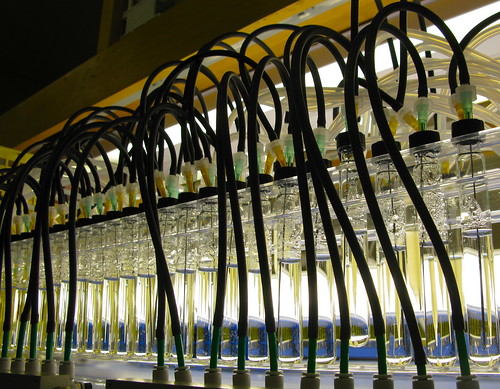 Here’s an article on the ever growing “algae revolution” where people stop chanting “drill baby, drill” and start chanting “grow baby, grow.” There are definitely upsides to algae, but do they outweigh the problems?
Here’s an article on the ever growing “algae revolution” where people stop chanting “drill baby, drill” and start chanting “grow baby, grow.” There are definitely upsides to algae, but do they outweigh the problems?One group of people who say yes are the shrimp farmers in Gial Bend, AZ. Here, the newest algae project is not controlled by an army of scientists or funded with millions of dollars worth of government research grants. Rather, it's a desert shrimp farm changing with the times to produce biodiesel from algae, using some of the same algae that feed the shrimp.
With biodiesel prices at $4.81 a gallon, according to the U.S. Department of Energy, these shrimp farmers hope to produce it for less than $3 a gallon. With these small farms being capable of producing 5,000 gallons of biofuel per acre in two years, there is definitely something to be said.
Algae is transformed into biofuels by pressing the oil out of the algae and then adding lye, sodium and ethanol as a catalyst to make the fuel more pure. The lye, sodium and ethanol can be reused.
Biofuels made from algae have an advantage over biofuels made from soybeans, palm oil or corn because algae is not a source of food, growing algae does not use agriculturally fertile land and algae can be grown in treated wastewater.
FROM ALGAE TO FUEL
* Algae is turned into biofuel in a process called transesterification.
* Biofuels made from algae contain around 90 percent of the energy in regular diesel but produce less CO2.
* Some forms of algae consist of more than 50 percent oil.
* Many vehicles would not have to convert to run on biodiesel.
FUEL POTENTIAL
Biodiesel potential, according to a report from the University of New Hampshire :
* 7.5 billion gallons of biodiesel can be produced in an area of 780 square miles.
* Biofuels take advantage of solar energy because plants use photosynthesis to convert solar energy into fuel.
* Certain strains of algae are among the most photosynthetically efficient plants.
* 15,000 square miles of algae production could replace all the petroleum-based transportation fuels needed in the United States.
Now if I could only start selling the algae growing on my f*&#ing fishtank...
Image provided by jurvetson




No comments:
Post a Comment